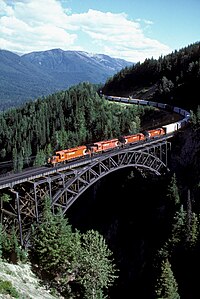Rogers Pass (British Columbia)
After awarding the contract, the government allowed CP to amend the designated crossing to the Kicking Horse Pass.
Although believing the change advantageous, hindsight indicates the Yellowhead and CP's 1898 Crowsnest Pass would have provided a more economical and strategic combination.
On May 28, 1881, the party followed a branch of the river past "Syndicate Peak" (now Mount Sir Donald), discovering a large level opening between the mountains where the waters flowed east and west.
[13] Although they had found a pass, they had been unable to explore its eastern approach, a distance of 18 miles (29 km) from the junction of the Beaver and Columbia rivers.
The discovery was due in part to the efforts of Moberly, his assistant Albert Perry and their First Nations guides, who had explored the Illecillewaet River on the west side of the pass fifteen year earlier.
[19] By May 1883, the westward railhead had only reached Medicine Hat, still leaving time to find an alternative to the equally problematic Kicking Horse Pass.
Captain Steele and his small North-West Mounted Police force protected construction manager Ross from confrontations with workers.
Not only did untreated wooden trestles provide all bridging, but cuttings were of minimum width, track was not ballasted,[25] and no snow sheds were built.
[26] Abandoning the damaged right-of-way on the western slope, north of the river, CP built the switchback Loops well clear of avalanche paths.
[72] Scheduled stops for breakfast, lunch, and dinner existed at Field, Glacier House, and North Bend.
[80] Oil storage facilities were built for the 1912 conversion to oil-fired locomotives in the mountains, eliminating firemen and fire patrols.
[83] One year after the tunnel opening, the right-of-way over the pass was handed over to the Parks Department for a wagon road, and the snow sheds were removed.
[85] Snow shed construction continued until 1890,[86] but only in places displaying consistent problems, and only where diversions were not a cheaper option.
In 1904, he added 15 or 16 bedrooms and a bathroom to the boarding house[109] to cater for the big summer demand from workers and tourists.
[114] The 1916 fire that destroyed the Morris store and residence[115] preceded the move to the new community of Glacier near the west portal.
A proposal to upgrade to Trans-Canada Highway standards a decade later, determined that the Selkirks route would be cheaper,[120] and not conflict with the Columbia River hydro-electric potential.
To keep the highway and railway open during the winter, the Royal Canadian Artillery has since used 105-millimetre (4.1 in) howitzers to knock down unstable snow under controlled circumstances to reduce avalanche hazards.
The latter engineer died instantly, and the several occupants of the caboose sustained fatal or serious injuries, but two children were thrown clear.
[130] 1887: A carpenter, who fell from a bridge in the vicinity, rolling 40 feet (12 m) into a stream, suffered a likely fatal skull fracture.
[132] That year, a young snow shed worker, who refused to seek and pay for medical treatment, died of fever.
[133] 1889: When a freight and passenger train collided in a snow shed to the east, one person was seriously injured and the locomotives received extensive damage.
[135] 1891: A car inspector slipped while boarding and fell beneath the moving passenger train, which cut off his left leg below the knee.
[141] 1907: While clearing track just west of Glacier, a snowplow plunged 20 feet (6 m) down a bank, dislodging a stove and inflicting severe injuries to the right thigh of a worker.
[142] Later that year, while infilling a trestle a few hundred feet east of depot, the brakes failed as the final cars were being emptied.
[147] Months later, an unmanned locomotive left the pass yard, and derailed 2 miles (3 km) east down the grade.
[148] 1911: A body found near Six-Mile Creek suggested a hopper, who boarded a freight train at the pass, had jumped to his death.
1967: Near the west portal, a runaway loaded gravel truck collided head on with an eastbound bus carrying 25 passengers.
[155][156] 1968: A bus carrying 14 children and two adults plunged 135 feet (41 m) down a gorge, but the occupants suffered only fractures and minor injuries.
[157] 1994: To avoid a head-on collision with a highway sanding truck, a tour bus carrying 21 passengers swerved into a snowbank.
[159] 2007: After crossing the centre line and crashing through a concrete guardrail, a 24-passenger bus, carrying 11 people and a driver, came to rest on the passenger side.

Water tower and 2nd station in centre.





